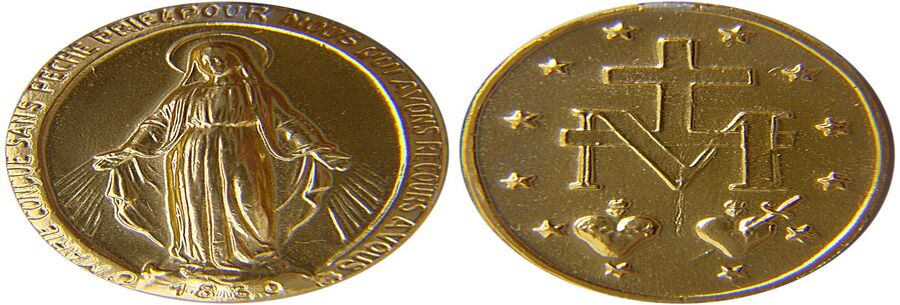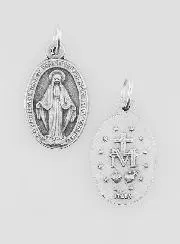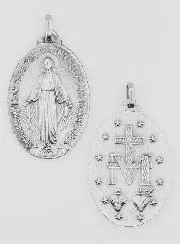The Miraculous Medal, an object of Catholic piety, has been worn and venerated throughout the world for almost two centuries. The medal has a distinctive origin, marked by supernatural events, Marian apparitions and a message of protection and mercy. By tracing the full history of the Miraculous Medal, we will better understand its importance, its symbolism, and how it has become a symbol of faith for millions of believers.
The origin of the Miraculous Medal: Historical and religious context
We are at the beginning of the 19th century, a period of spiritual renewal in France. After the trials of the French Revolution, believers were returning to religious practices with renewed faith. It was in this context that religious communities developed to meet the spiritual and material needs of the population.
The Miraculous Medal owes its creation to one of these communities: the Congregation of the Daughters of Charity, founded by Saint Vincent de Paul and Saint Louise de Marillac. In this congregation, a young novice, Catherine Labouré, was admitted to the novitiate in 1830. Catherine was a simple, pious young woman who, from an early age, felt a deep love for the Virgin Mary.
The apparitions of the Virgin Mary to Catherine Labouré
The story of the Miraculous Medal really begins in July 1830, when Catherine Labouré, aged just 24, experienced several apparitions of the Virgin Mary. These visions took place in the chapel on the Rue du Bac in Paris, part of the convent of the Daughters of Charity. The first apparition took place on the night of 18 to 19 July. That evening, Catherine was awoken by a "child" (whom she considered to be her guardian angel) who asked her to go to the chapel. There she found the Virgin Mary seated on a chair near the altar. Catherine rushed to her feet, and Mary spoke to her tenderly, informing her that God wanted to entrust her with an important mission. During this first apparition, Mary shares prophecies with Catherine about France and the Church, and asks her to have confidence in God.Second apparition - The Request for the Medal (27 November 1830)
On 27 November 1830, the Virgin Mary appeared to Catherine Labouré again. This time, she entrusted her with a specific task: to have a medal struck according to a model she showed her in a vision. The Virgin is shown standing with her arms open and rays of light emanating from her hands. Around the figure is the following invocation: "O Mary conceived without sin, pray for us who have recourse to you." Mary explains that these rays symbolise the graces she obtains for those who ask her for them.
The vision continues with the back of the medal: a cross surmounts the letter "M", below which appear two hearts, that of Jesus (crowned with thorns) and that of Mary (pierced by a sword). Twelve stars surround the whole, symbolising the Church and its apostles. The Virgin Mary promises Catherine that all those who wear this medal with faith will receive great graces.
The creation of the medal and its first miracles
After these apparitions, Catherine Labouré spoke about it to her confessor, Father Jean-Marie Aladel. At first, he was sceptical. But Catherine persisted, claiming that the request had come from the Virgin herself. After much thought, and under pressure from the detailed insignia provided by Catherine, Father Aladel finally decided to submit the request to the Archbishop of Paris. Authorisation to strike the medal was then granted. The first series of medals was produced in June 1832. Stories of miracles, healings and conversions soon accompanied the distribution of the medals. The faithful testified to the protective effect of the medal, a new-found inner peace and inexplicable cures. This is how the medal came to be known as the "Miraculous Medal". In just a few years, millions of medals were distributed, particularly in France, and then throughout the world.
The symbols and meaning of the Miraculous Medal
Each element of the Miraculous Medal has a profound symbolism, referring back to the Christian faith and Marian devotion.
The Front of the Medal: son the front, the Virgin is depicted with her arms outstretched, rays of light emanating from her hands, symbolising the graces she dispenses. The prayer around the figure, "O Mary conceived without sin, pray for us who have recourse to you", is a reminder of the dogma of the Immaculate Conception, officially proclaimed by the Church in 1854. It shows Mary as protector and intercessor with God on behalf of mankind.
The reverse side of the Medal: theback side of the medal depicts a cross over an "M" symbolising Mary's union with the Passion of Jesus. The two hearts, one surrounded by thorns (the Sacred Heart of Jesus) and the other pierced by a sword (the Immaculate Heart of Mary), symbolise the love and suffering shared by Jesus and Mary for the salvation of humanity. The twelve stars around the medal recall the twelve apostles and symbolise the Church as a whole.
Devotion to the Miraculous Medal
Rapidly, the Miraculous Medal became an object of universal devotion. It is used as a symbol of protection, comfort and healing. Many people attribute special graces to wearing it. The medal also contributed to a resurgence of faith, as it allowed those who wore it to affirm their Catholicism and their devotion to Mary. Catherine Labouré, for her part, continued to live a discreet life, known only to her superiors and confessors. She served the poor and the sick within her congregation until her death in 1876. She was canonised by the Church in 1947.
Where to find a Miraculous Medal?
The Chapelle de la Rue du Bac, the site of the apparitions, is today a pilgrimage site where millions of people come to pray and obtain blessed medals. Other Marian shrines, such as Lourdes and Fatima, also offer medals. Believers can also find Miraculous Medals in religious shops and online boutiques. It is often made from a variety of materials, from gold to silver to brass, making this object accessible to all.
The Miraculous Medal embodies a message of love, protection and grace. It reminds those who wear it of Mary's maternal presence and invites them to turn to her in times of need. Throughout the world, the Miraculous Medal continues to transmit this message of peace and faith, bringing believers together in a devotion that endures, in homage to the Virgin Mary and the mission passed on to Catherine Labouré.




















